The Physics of Rough Roads
Stray from paved streets, and you will likely encounter a “washboard road” created by backcountry traffic—a corrugated stretch of dirt track that can play havoc with a vehicle’s suspension and a passenger’s equilibrium. Railway cars can also create equally destructive ripples in the metal rails with repeated travel. Researchers have studied this effect with experiments and theoretical modeling, but these efforts tend to rely on ad hoc mathematical terms whose physical meaning is unclear. In Physical Review E, Baptiste Percier of the École Normale Supérieure in Lyon, France, and colleagues report on their combination of measurements and modeling that shows that the corrugation pattern seems to depend primarily on the mass of the vehicle, rather than any effects of suspension or tires. The findings could point to ways to mitigate the formation and damage caused by ripples in rails and roadways.
From earlier work, the authors found that they could accurately simulate ripple growth by simply dragging a metal plow blade across a track made from sandblasting powder. In the new work, they measured the forces acting on a plow moving across the sand bed under different velocity conditions, both in the case of the onset of a ripple pattern in an initially flat surface, and for a plow moving over an imposed sinusoidal ripple. In the latter case, the plow can cause the ripple to grow in amplitude. By means of stability analysis, Percier et al. show that they can calculate the critical velocity for onset of the ripple as well as the ripple wave number with the largest growth rate. Their model reproduces well the characteristics of washboard roads, but the bigger challenge will be applying these methods to rail cars, where the metal rails are subject to plastic deformation rather than granular flow. – David Voss





